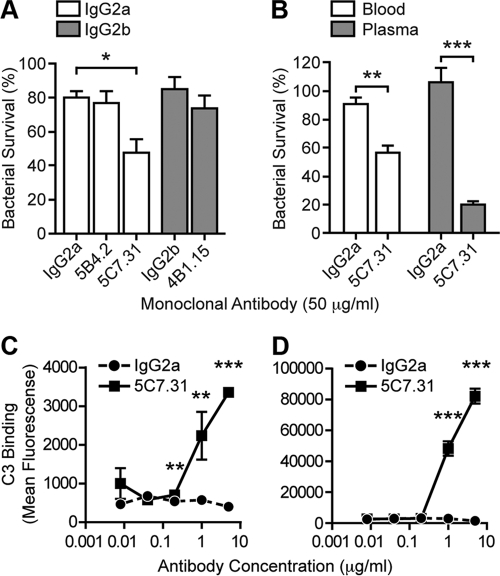Fig. 7.
Anti-rOmpB 5C7.31 MAb reduces R. conorii viability in mouse blood through a complement-dependent mechanism. (A) R. conorii survival in mouse blood. Fresh blood drawn from C3H/HeN mice was infected with 106 PFU/ml R. conorii. Blood samples were supplemented with rOmpB (5B4.2, 5C7.31, and 4B1.15) or isotype-matched control (IgG2a and IgG2b) MAbs at the specified concentrations and incubated with rotation at 37°C. After 60 min, samples were cooled on ice and blood cells were lysed with saponin. Viable R. conorii organisms in each sample were enumerated by limiting dilution on monolayers of Vero cells. Bacterial survival was calculated as the percentage of viable R. conorii organisms recovered from the blood at 60 min relative to that at 0 min prior to the addition of MAb. The data are the combined mean survival ± SEM from three independent experiments performed with triplicate samples. (B) R. conorii survival in freshly drawn mouse blood or plasma supplemented with anti-rOmpB 5C7.31 or the IgG2a isotype-matched MAb, similarly to that described above. Plasma was generated by removal of cells from blood by centrifugation at 10,000 × g for 3 min. The data are the combined mean survival ± SEM from two independent assays done in quadruplicate. (C and D) R. conorii was incubated with PBS-10% mouse (C) or human (D) serum supplemented with 0.008, 0.04, 0.2, 1.0, or 5.0 μg/ml 5C7.31 or IgG2a at 37°C for 20 min. The cells were washed twice in PBS and fixed with 4% PFA, and surface-bound C3 was detected with FITC-conjugated goat F(ab′)2 anti-human C3. The binding of C3 antibody to R. conorii was measured by flow cytometry. The data are combined from three independent analyses conducted in triplicate (twice) and duplicate. The error bars represent the SEM. A total of 10,000 R. conorii organisms were analyzed per replicate. In panel A, one-way ANOVA with Bonferroni's test was used for group comparisons within isotype-matched groups. Panels B, C, and D were analyzed by two-tailed Student's t test. *, P < 0.05; **, P < 0.01; ***, P < 0.001.

